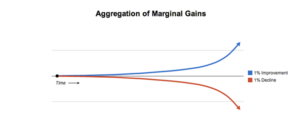At the Innovation Centre, we love looking at different ways of thinking for people regarding innovation and inspiration to apply to scaling businesses. This article will show you that the Marginal gains strategy can be the right concept for your company in this challenging business climate. Quite rightly most businesses have been looking at the ‘big wins’ but what about all the little improvements in the company that can add up to significant wins too? This is Marginal gains.
The concept
Firstly this concept isn’t new, Marginal gains is just the new buzz word for this approach. If you have been in business for a while, you’ll know it has connections to continuous improvement or Kaizen methodology. Which let’s be honest can be seen as a little old fashioned and even boring.
The premise of Marginal gains is this….making just 1% of incremental improvement in any process or area of business can have significant effects on performance when added up across the multiple areas of a company. This can be seen right across professional sport and in the British Olympic teams.


Pixabay 2020
Sir Dave Brailsford’s impact
This ‘new’ way of thinking was brought to the fore by British cycling’s Sir Dave Brailsford took over British cycling after the poor showing in Atlanta 1996. During a ten-year span from 2007- 2017, British cyclists won 178 world championships and 66 Olympic or Paralympic gold medals plus captured an impressive 5 Tour de France victories in what is widely regarded as the most successful run in cycling history.
His 1% of single individual continuous improvements became the team mantra and transformed the fortunes of the team. Brailsford understood that if you break everything down that you can think of, then give it clarity and improve it by just 1% you can create impact across the board to a much greater % value.
He looked at the obvious on how athletes were training and what their diet was but this went to the extreme with looking at how they slept, what position, what pillow and then made sure it was optimised by taking beds and pillows on every trip they did for consistency. They even hired a surgeon to teach each rider the best way to wash their hands to reduce the chances of catching a cold (sound familiar).
That’s commitment and as the results show, it worked.
Can 1% really make a difference
You bet it can! You are probably thinking that 1% is too small a margin to be noticeable or even worthwhile thinking about let alone implementing. When these 1%s start adding up 1+1+1+1+etc you start to get the impact/percentages your Directors or line reports are hoping for.
And the best part is the maths prove it, as shown below:


These small choices don’t make much of a difference straight away but add up over the long-term. As time goes on, these small improvements compound and you suddenly find a very big gap between people/businesses who make slightly better decisions on a daily basis and those who don’t. Sometimes doing nothing at all means losses that creates a gap negatively.
As an example, 1% each day can equate to being 37x better off over a period of a year (Clear 2019).
How to apply in business
In early 2014 at Cranfield, David Denyer created the 15 steps to peak performance to showcase how this can start to be applied to business success.
Now Marginal gains obviously takes some rigour to focus on multiple often interlinking small ‘tweaks’ that can be made inside a business. But the benefit of these small changes rather than bigger ones means you don’t have to overhaul the entire business in one go and can really test and learn the outcomes, especially in a Start-up or SME.
The next step on this journey is to spend some time working out and mapping your business from logistics/distribution, finance, buying, sales & marketing, IT and even people. Leave no stone unturned and get all your team involved to see what can be improved on by just 1%.
As added inspiration on what can be achieved, I remind you of the infamous American Airlines cost-cutting exercise from 30 years ago, by taking out just one olive per customer they saved over $40,000 per annum. Forbes has written an excellent article on how small businesses can capitalise on this approach to save time and money.
What can you improve 1%?
So if you adopted this approach type what could you improve within your business? What should you prioritise? And what is worth your time?
How about this list for starters to get you going:
Reduce Debtors days: one day at a time
1% price increase at least two times a year
Optimising the organisation of office
1% reduction in sending/receiving emails
Better and more accurate budgeting
Fewer meetings, or at least shorter ones (under 1 hour)
Purchase stock 1% cheaper
More efficient policy communication
Reduction in employee lateness
Reduce packaging by 1%
Slicker hiring and HR processes
Better use of data especially for sales and marketing
Upgrade IT systems, hardware and broadband to be 1% more efficient
Doing things right first time to avoid duplication
Improve customer service quality so that there are fewer complaints
Final thought
Hopefully, this may have convinced you on the impact changing parts of your business by just 1% can have. We firmly believe this is the right approach for every business to at least try and see what benefits they can get out of it in the coming months.
If you are after more innovative business advice and want to see what the centre can bring to your business, please contact us at info@innovationcentre-kg.co.uk or 01206 405 500
Author : Neil Griffin Innovation Director
